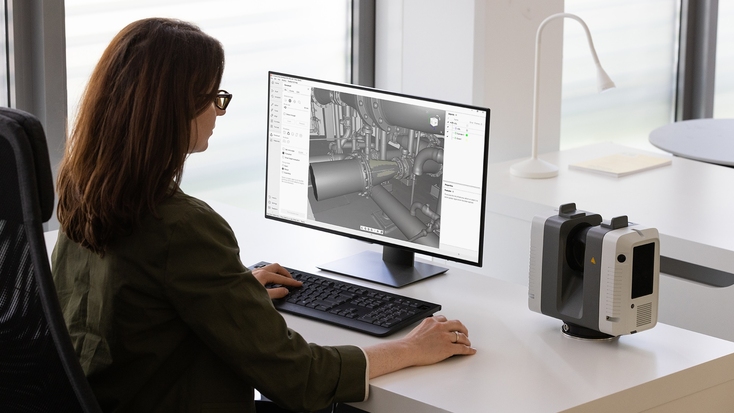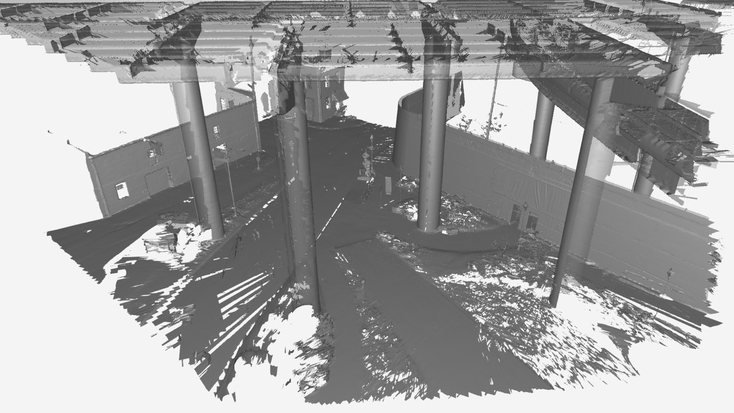レーザー3Dスキャニングとは
レーザー3Dスキャニングは、オブジェクトや空間環境の高度に詳細な3Dモデルを製作する最先端のテクノロジーです。この記事では、その機能方法、現在販売中のスキャナの種類、その用途、及び利点についてご説明いたします。
実在する物品をデジタル領域へ取り込む手段であふれている世界において、それがスキャナ、カメラ、フォトグラメトリ用ソフトウェア、もしくはLiDARセンサー搭載のスマートフォンのいずれであっても、利用可能な選択肢の間を上手く『航海』していくことは手に負えないものになり兼ねません。この記事では、最も幅広く利用されているスキャニング技術である、レーザー3Dスキャニングを徹底解剖していきます。

レーザー3Dスキャニングとは
簡単に言って、レーザー3Dスキャニングとは、あらゆるオブジェクトや空間環境からレーザーを光源として利用することによって正確な3D情報を取得する工程のことです。すなわち、このテクノロジーはレーザー光線に依存し、オブジェクトや場所、景観のサーフェスまでの距離を測定し、その極めてリアルな3Dモデルを製作しているのです。3Dレーザースキャニングはエンジニアリング、設計、建築分野において普及しているツールでもあり、通常はあらゆる構造物の現況の記録に利用されています。
3DレーザースキャナはLiDAR(light detection and ranging、光検出・測距技術)を利用し、レーザー光をオブジェクトに照射することで、その正確な場所、及び距離の記録、測定を行います。最終的に点群ファイルを生成する、この種類のスキャナはリバースエンジニアリングや品質検査から遺産保全や法医学に至るまで、数え切れない程の用途に非常に貴重となるデジタルデータをもたらします。 当テクノロジーの人気を更に高めているのは、最新のレーザースキャナが持ち運び可能で安全で簡単に取り扱うことができる上、ミリメートルの水準まで正確である、という点です。
レーザー3Dスキャニングの機能方法
要点を絞ってご説明すると、レーザー3Dスキャニングは光パルスを高速に発することで機能し、光線はオブジェクトに反射し、スキャナのセンサー(LiDAR)へ戻ります。それぞれのパルスに対し、その送信から受信までの経過時間が計算されることで、当該スキャナとオブジェクト間の距離が測定されます。各データポイントは、既知のXYZ座標を持つピクセルへと変換されます。

LiDARスキャナのワークフローは、以下の手順に分割されます。
レーザー放射:スキャナがレーザービームを通常は肉眼では見えない、赤外線スペクトル内の高速な短パルスの形でオブジェクト上に照射します。
パルスの反射:レーザーパルスがオブジェクトに当たると、スキャナへと跳ね返ります。オブジェクトのサーフェスの色彩、テクスチャ、反射性などの特性が、レーザー光線のスキャナへの戻り方に影響を与えます。
タイム・オブ・フライト測定:スキャナが、放射したパルスがオブジェクトへ到達して戻ってくるまでの経過時間を測定します。測定された時間はその後、光速を利用して距離に変換されます。
点群生成:オブジェクト表面の複数のポイントへの距離の計算を行うことで、スキャナは点群と呼ばれる、非常に詳細なデータポイントの集まりを作成します。それぞれのポイントは、空間内の3Dでの位置を示します。
データ処理:点群は詳細な3Dモデル、もしくはマップへと処理されます。それぞれのポイントはスキャンされた空間を正確に反映しています。その上で、このデータには視覚化、分析が行われ、完成させる3Dモデルの製作に利用されます。
キーポイント
レーザー3Dスキャニングはレーザー光をオブジェクトに照射し、反射光を計測することによりオブジェクトの形状及び寸法を見極める形で機能します。詳細な点群が収集データより生成され、後に様々な用途における分析及び利用が可能な3Dモデルへと処理されます。
レーザー3Dスキャナの種類
3Dレーザースキャナは様々な用途に合わせて個別に開発されており、その種類には目を見張るほど多くのものがあります。取扱い製品はハンドヘルド式、もしくは定置式及び三脚取り付け式の独立型機器から、携帯式、あるいは飛行式のレーザースキャニング設備やロボットアームなどの複合型の産業水準のソリューションに亘ります。レーザースキャナは、タイム・オブ・フライト、位相差、そして三角測量の三種類の技術を利用しています。このそれぞれの更なる詳細について、見ていきましょう。
タイム・オブ・フライトシステムはパルス測定システムとも呼ばれ、レーザー光の単独のパルスを放射し、光がスキャナのセンサーへ戻るまでの経過時間を計ることで終点への距離を特定する形で機能します。

位相差システムも放射レーザー光を利用しますが、光の強度は特定の波形で調整されます。強度パターンの反射は、オブジェクトの表面での衝撃に置換されます。送信されたレーザー信号と受信されたものの強度の差の測定により、正確な距離の計算が可能となります。

三角測量を基にしたレーザースキャナは、レーザー光をオブジェクト上に放射し、搭載しているカメラセンサーで反射光をキャプチャすることで機能します。このシステムは三角法による三角測量法を利用し、レーザー光源、センサー、及びオブジェクト表面の反射先の三点間に三角形を形成することで、オブジェクトまでの距離を計算します。一般的に短距離(五メートル以内)での用途に利用される三角測量式スキャナは、一センチから約二、三メートルに亘る、小規模から中規模の大きさのオブジェクトのキャプチャに長けています。

異なる種類のオブジェクトのキャプチャ、及び異なる距離からの操作のために開発されたレーザースキャナの良い例となる二台が、Artec PointとArtec Ray IIです。前者が掌の中で最高〇.〇二ミリメートルの精度を提供する計測業水準のハンドヘルド式レーザー3Dスキャナである一方、後者は他に例を見ない、十メートルの距離から一.九ミリメートルの3Dポイント精度をもたらす長距離用LiDARスキャナです。
キーポイント
レーザー3Dスキャナは、タイム・オブ・フライト、位相差、そして三角測量の三種類の測定技術のうちの一つを採用しています。タイム・オブ・フライト型スキャナはレーザー光のパルスがスキャナへ戻るまでの経過時間を計り、位相差型の機器は変調光の波形を比較することで距離を測定します。短距離からの測定に最適な三角測量型スキャナは三角法を採用し、レーザー光源、オブジェクト、及びセンサーの間で三角形を形成することにより距離を特定するため、小規模から中規模の大きさのオブジェクトのキャプチャに向いています。
Artec Pointは携帯可能な3Dレーザースキャナで、オブジェクト及び空間環境の迅速で正確なスキャニングに最適です。このArtec社では初めてとなるターゲットベースのスキャナは極めて正確な3Dデータを高い反復可能性でキャプチャするため、産業、エンジニアリング、設計における用途に不可欠の機器となっています。本スキャナは最高〇.〇二ミリメートルの非常に高い精度、及び解像度を提供いたします。その極めて高速なスキャンにより、秒速で二百八十万もの寸法の取得が可能となり、迅速で効率的なデータ収集を確実なものとします。Artec Pointは黒色や光沢のあるサーフェスを含む、更に複雑度の高いサーフェスにもレンダリングを行います。出来栄えを最大限に向上させるためには、グリッド、平行、及びシングルレーザーモードが選択可能で、狭い領域でのスキャンには急勾配の視野角に固定されたカメラをご利用いただけます。
一方、Artec Ray IIは産業、及び建築分野の用途における大規模で高精度のスキャニング向けに設計されています。高度なレーザー技術を活用し、同機器は特筆すべき精度をもたらすため、風力タービン、船舶のプロペラ、巨大な航空機、橋梁、工場生産現場、科学捜査向けの現場、遺跡発掘地などのいずれの場合であっても、巨大なオブジェクトの離れた距離からの正確なキャプチャに理想的な機器となっています。リバースエンジニアリング、品質検査、犯行現場の記録、もしくは社会基盤の経時変化の評価などのいずれの用途でも、Artec Ray IIは高い3Dポイント精度、及び同クラスで最高の角度精度を誇りをもってご提供いたします。
レーザー3Dスキャニングの使い道
レーザースキャニング技術は、詳細な空間データのキャプチャの際に他の追随を許さない精度、速度、そして多用途性をご提供することで、多様な産業分野に変革をもたらしています。同技術は、建設や建築から、文化遺産や製造業に亘るまでの分野で重要な役割を果たしています。驚くほど正確な3Dデータを取得することで、レーザー3Dスキャニングは製造、修復、維持管理、及び調査研究において設計上の不一致の発生を最小限に抑え、正確なデジタル化を確実にもたらすことが可能なため、異なる分野の専門業者の方々のワークフローの質の向上を支援しています。その極めて詳細なデジタルモデル作成能力により、レーザースキャニングは手際の良い計画立案、連携の強化、及びリスク低減を実現させ、多くのプロジェクトにおいて必須のツールとなっています。
主なレーザースキャニングの用途は、以下のようなものです。
リバースエンジニアリング
3Dレーザースキャニングは、リバースエンジニアリングにおいてオブジェクトのジオメトリをキャプチャすることにより非常に重要な役割を果たしており、取得データは後に複製、加工することが可能です。例えば、予備の無いパーツ、もしくは製造中止となったパーツを機械や車両のために複製する必要の生じた企業がある場合、レーザースキャニングであれば、同企業では現物となる部品の非常に正確な3Dモデルの製作が可能となります。このようなモデルは許容値の厳しい代替パーツの製造への利用が可能で、誤差が最小限に留まる上、手作業での計測も不要となり、成果品は確実にぴったりと所定の場所に納まります。
一例として、オランダのある高速ボート製造業者の方々は、手製の高耐久性の業務用ボートのデザインを再現されました。担当された班は三艘の巨大な船舶をリバースエンジニアリング用の3Dモデルのご製作のためにスキャンされ、業務用ボートの構築は容易なものとなり、他に例を見ない精度の確保を実現されました。
品質検査
レーザースキャニングは、品質管理及び検査には欠かせません。例を挙げると、橋梁や防水壁の検査においては通常、構造の完全性、構造配置、及びサーフェスの状態の査定向けの高解像度の点群生成に利用されています。このデータにより、エンジニアの方には時間に伴う変形の特定、監視が可能となり、安全性並びに整備計画の強化のための設計仕様への準拠が確実なものとなります。
GoMeasure3D社は自社プロジェクトの一つで、運用中の陸橋直下にある全長三.二八マイルの防水壁の損傷検査の定量化を可能とする方法を発案されました。その巨大な構造物の一部をArtec Ray IIにより正確にキャプチャすることで、同社のエンジニアの方々は変形の見極め、腐食測定、維持管理の必要性の査定に最適な、高いレベルのディテールの取得を実現されました。

建設
本技術は施設の施工完了時の状態の記録、及び経時変化の記録にも役立ち、建築、構造、および建築設備(MEP)の要素のような、最も複雑な部類に該当するディテールをもキャプチャします。施設の改修時を例に取ると、3Dレーザースキャニングは現状の構造骨組、機材、及び配管についての正確なデータのご提供が可能です。このデータにより、エンジニアや建築家の方は新たなデザインをシームレスに組み込み、現存の構造物と提案された更新内容の間の不一致の発生を防ぎます。当技術の精度は、最高二~四ミリメートルまでの精度を持つ点群を生成することで、初期段階で起こり得る問題点を特定し、プロジェクトの迅速な実行をより容易なものとし、改修が正確な仕様通りに行われることを可能とします。
建築設計
3Dレーザースキャニングは、建築物のあらゆる要素の高精度の3D空間情報を提供することで建築設計を効率化します。施設の再設計の際、レーザースキャニングは空間を壁や窓から冷暖房空調設備に至るまでの目視できる特徴のすべてと共に3Dで表現するために利用されます。このデータにより、建築家の方は必要とされるすべての寸法をご用意いただけます。このことに加え、3Dスキャンデータは施設のすべての部位が設計図に適合していることを証明するために充分な程度の詳細情報をも含んでいます。

遺産保全
遺産保全の専門家の方々は、文化的史跡の非侵蝕性で高精度の記録、及び保存手段としてレーザー3Dスキャニングを頼りにされています。古代建造物、遺跡、あるいは遺跡発掘現場など、3Dによる保存対象が如何なるものであっても、レーザースキャニングはあらゆるオブジェクトの細かなディテールをキャプチャし、修復、保護、及び仮想現実での見学ツアーにご利用可能となるデジタル複製を作成します。このことで歴史や文化の保護が可能となる一方で、以上の貴重な史跡の詳細な探究、及び研究に未来の世代が携わっていくことも実現します。
このことを成就された見事な一例が、オランダのハーガ教会(Hagha Church)の物語です。修復期間中に、作業に携わった方々が教会の老朽化した木製の床の下部で墓石を発見されました。当初の目的は建物の補強でしたが、担当班の方々は新たに発見された遺産を今後も地域の人々にご鑑賞いただけるように対処されました。この実現には長距離用3Dレーザースキャナが利用され、中に含まれる未発見の『秘宝』も含めた教会全体がキャプチャされました。

発電所の維持管理、及び改修
発電所の改修では、ボイラーやタービン、配管などの現状の基礎構造の正確な記録を入手することが不可欠ですが、この業務にレーザー3Dスキャニングは必須のものとなります。一例を挙げると、年季の入った発電所の新たな環境基準を満たすための改修の際には、同テクノロジーによれば、発電所の基礎構造全体の3Dモデルの製作が可能となります。その上で、モデルはエンジニアの方が改良を計画し実施する際のお役に立ち、新たに完成した器材は現状の配置に継ぎ目も無い形で確実に納まります。更に、危険な箇所への仮想現実的な実地検証もでき、安全上のリスクを低減させることに繋がります。また、摩耗しやすい部品の特定も可能で、先を見越した維持管理スケジュールの作成、必須となる素材の寿命の延長に役立ちます。
施設向け修復品の製造
製造業においては、工場の詳細で正確な竣工時のデータは改修、及び拡張に必要となりますが、3Dレーザースキャニングは器材、構造、並びに施工過程についての正確な情報をもたらします。一例として、 乗用車製造工場で組み立てラインの改修が必要となった場合には、レーザースキャニングは新たな機械を利用可能な空間にぴったりと納める際にお役に立ちます。3Dデータは設置計画、及びすべての部品の確実でシームレスな取り付けにご利用いただけ、コストの高い設置時の取付誤差や遅れ発生の恐れを低減させます。

法医学・科学捜査
法医学捜査においては、専門業者の方に綿密な分析の目的で詳細な犯行現場や事故現場のキャプチャを安全に行う必要性が生じた際に、3Dレーザースキャニングをご採用いただけます。例えば、交通事故発生時には、レーザースキャニングは車両の位置、路面標識、あるいは照度や視界などの環境因子などを含めた事故現場の正確な3Dモデルの作成が可能です。その上で、このようなデジタルによる物証は事故の再現、法的手続きにおける支援、事故再現の専門家の方が発生状況を把握するための貴重な詳細情報の提供にご利用いただくことが可能です。
この用途のもう一つの例としては、法医人類学が挙げられます。Mercyhurst Universityでは有資格者である教授の方が、3Dスキャニングによって数百の骨をデジタル化された上で、画期的な仮想現実の講座向けの解剖学的に正確な3Dモデルの製作に利用されました。
キーポイント
レーザー 3D スキャニングは特定の専門的任務向けに正確で即時のデータをもたらすことで、多くの産業分野を変革しています。建築設計の強化から工場の改修の促進や科学捜査での支援に至るまで、当テクノロジーの適用範囲は幅広く、更に拡がっています。
レーザー3Dスキャニングの利点
3Dレーザースキャニングは、その高度に詳細で正確な3Dデータのキャプチャ性能により、多くの分野で必要不可欠のツールであることを立証されています。以下に、3Dレーザースキャニングの主要な利点をいくつかご紹介いたします。
反復可能な高い正確性
レーザースキャニングでは驚くほど正確な計測が可能で、リバースエンジニアリング、品質検査、建設、製造業などの計測業水準のデータが必須である用途で実際に利用されています。
迅速なデータキャプチャ
レーザースキャナは素早く膨大な量のデータを収集する一方で、確固としたトラッキングも維持します。手作業での計測と比較すると、広範囲のサーフェス領域の一定の距離からの3Dスキャニングにより、現地の作業関係者の方々にはより高速な作業の実施、及び安全性の向上が実現します。
コスト効率の良いソリューション
一度のスキャンで迅速にデータキャプチャを完了することで、レーザー3Dスキャニングは寸法誤差により起こり得る、コストのかかるやり直しや遅れの発生を抑えます。当テクノロジーはCAD、及びBIMソフトウェアへもシームレスに統合することが可能で、資源を節約し、プロジェクト予算を順守した上での業務の遂行を支援します。
柔軟性及び多用途性
レーザースキャニング技術は非常に適応性が良く、オブジェクトや空間で大規模なもの、複雑なもの、もしくはスキャンの難しい場所にあるものからもデータキャプチャが可能です。屋内、屋外の両方、更には業務を行いづらい状況でも採用が可能であるため、専門業者の方には様々な規模の課題に対処していただくことが可能となります。
改善された設計・記録方法
3Dレーザースキャニングで生成された点群は極めて本物のような3Dモデルの製作の基礎となり、設計品は仕様に適合した形で製作され、誤差発生の恐れも最小限に留められます。また、 記録方法も従来と比較して改善されており、作業担当班間の共同作業の質の向上に繋がり、プロフェッショナルの方にはプロジェクトの視覚化、計画、監視をより効果的に行っていただけます。
レーザー3Dスキャニングの潜在的課題
レーザー 3D スキャニング技術は様々な分野で非常に多くの長所を発揮しますが、考慮すべき潜在的な課題もいくつかございます。 高品質のレーザースキャニング機材にはかなりの額の投資が必要となるため、主な障壁となるのはコストです。幸運にも、コスト効率が高く、それでもハイエンドのスキャナの提供するような例外的な高品質の成果を挙げることも可能なソリューションの選択によって、この課題の難易度は低減されます。
3Dスキャンデータの処理、及び分析用ソフトウェアは、特に複雑に入り組んだモデル製作向けのものについては、賢く選択する必要があります。例を挙げると、Artec Studio 19は高性能ながら直観的にご利用いただける3Dスキャニング・処理ソフトウェアであり、スキャナの潜在性を最大限に引き出す高度な機能が満載です。予算がより限られている比較的小規模の業種やプロジェクトでは、維持管理費、講習費、及びライセンス料が出費に含まれる場合も生じますが、3Dデータの品質の高さや一貫した高精度の成果のような長期にわたる恩恵により、以上の投資は価値のあるものとなります。

大容量のデータセットの管理も、レーザースキャニングの課題の一つです。3Dスキャナで生成された点群は何百万、ひいては何十億のデータポイントで構成されている場合もあるため、大容量のファイルは保存、処理、管理が難しくなり、性能の安定したソフトウェア、及び高性能のコンピューターシステムを必要とする場合が良く生じます。そのような詳細なスキャンデータを扱う場合、特にそれが大規模の構造物や空間環境のものである場合はワークフローの進行を遅れさせ、プロジェクトのスケジュールの遅延にもつながります。未加工の点群をCADドローイングやBIMモデルのような利用しやすい出力に変換することも、非常に時間がかかります。しかし、Artec Studio 19のようなツールであれば、その工程を簡略化することが可能です。巨大なデータセットを扱うよう設計された当ソフトウェアは3Dモデリング、リバースエンジニアリングや品質検査のような用途を遥かに効率的で、かつ分かりやすいものとします。
周辺の条件も、考慮に入れる必要があります。スキャンデータの正確さは光の状態、サーフェスの反射性、及び素材の特性に左右されることが多く生じます。例えば、ガラスや鏡のような反射性の高いサーフェス、もしくは非常に暗いサーフェスはデータキャプチャを複雑化させることがあり、結果的に欠落部を持つ不正確なスキャンデータの取得に繋がり兼ねません。こういった状況では、適切なスキャナ、特に光の少ない条件下や課題となるサーフェスからでもデータキャプチャが可能となる機器に頼ることが不可欠となります。Artec社の3Dレーザースキャナはこのような条件下での使用において卓越しており、最高品質の成果をお約束します。その上、Artec社によるレーザースキャニングをご利用になるには、トレーニングはそれほど必要ありません。 弊社のハードウェア、ソフトウェアは双方とも利用しやすく、習得も比較的容易です。初心者の方でも二時間以内に正確なデータの取得、及び取得結果の解釈方法を身に付けていただけます。Artec社の直観的なテクノロジーはデータ誤差、並びに誤った解釈を最小限に抑えるため、異なるレベルのエンジニアリングの専門性を持つユーザーの方々に当テクノロジーの利点をご活用していただけるようになっています。

レーザー3Dスキャニングの未来は
先を見据え、3Dレーザースキャニングはエンジニアリング、建設、製造業、並びに保護事業などの産業分野を一変させようとしています。このテクノロジーの未来を形作る動向の主となるものは人工知能(AI)及び機械学習(ML)の統合であり、点群の処理のような複雑な工程を全自動化させるため、マニュアルでの入力の機会を低減させ、効率性を向上させます。AIアルゴリズムはリアルタイムでの品質管理を可能とし、設計モデルとスキャンされた構造物の間の不整合性を特定する一方で、MLは現存する構造物の劣化による損傷を予測します。以上に加え、最新型の3D スキャニング機器の使いやすさと携帯性により、鉱業や建設のような産業分野においては、小規模の企業の方にもデータキャプチャを更に簡単にご利用いただけるようになっています。
3Dレーザースキャニングにおける更なる進歩に数えられるのが、仮想現実(AR)と拡張現実(VR)のより進んだ形の統合で、専門業者の方々には3Dモデルとの没入的な形でのインタラクションが可能となり、設計内容の視覚化、そして意思決定全般が改善されます。データ取得、及び処理も加速され、3Dスキャニングは進行の速いプロジェクトにおいて、その効率性を益々向上させています。質の向上したセンサー及びソフトウェアにより改善されたスキャニング精度により、航空宇宙産業や建設のような産業分野でのより厳しい許容差の達成、及び廃棄物量の低減が実現しています。全般的にみると、この先数年においては、3Dレーザースキャニングはその性能並びに速度を更に向上させ、多用途性を高めていき、データキャプチャの品質、及びその用途の幅広さを全くの新たなレベルへと引き上げていくことが約束されています。
こちらを次にお読み下さい
ラーニングセンターに
さらに詳細が記載されています
3Dスキャンの世界から始めるのは少しハードルが高いかもしれませんが、3Dプリントの背後にあるテクノロジーを理解するのに少し時間をかけるだけで、全てが明確になります。ご自身の目(スキャナの起源ですね!)から、現在市場に出ている最新の3Dスキャナまで、すべてがどのように機能するのかをここに記述いたします!
何かを3Dスキャンするためにかかる費用は、沢山の要因に依ります。こちらのガイドでは、3Dスキャンのコストに影響を与える主な要因について説明し、果たして独自のスキャナを入手する方が理にかなっているのか、それとも専門のスキャンサービス業者を利用した方が良いのか検証していきます。
世界最先端の3Dスキャナの数種が、どんな大きさの、かつどのような複雑さを持つオブジェクトもキャプチャしていく過程を本当の意味で充分に把握するには、まず、構造化光の役割について詳しく知ることが必要です。この簡単に読める記事では上記の点に加え、CMM機器やCGIフォトグラメトリなどの他のテクノロジーよりも、構造化光を利用する方が優れている点についても学んでいただけると考えています。また、構造化光3Dスキャナを扱う際の課題となる面についても、一部ご説明します。




